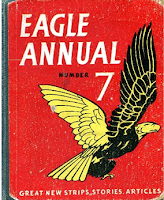(First posted 12th April, 2016)
“You can bowl, Hunt.” Mr. Ellis threw the ball at me, hard, his superior smirk turning into a contemptuous sneer.
He had mistaken me for Dave Hunt. It was easily done, we were both thin and feeble, but to correct him would have gained yet more of his unwanted attention. He was right though: I could bowl, except he didn’t know it yet.
We were in the school cricket nets. Mr. Ellis had decided to demonstrate some batting strokes and for once had invited one of the sport-averse, wimpy weaklings to participate: someone whose ineffectual bowling would be easy to deal with. What he was unaware of was that, coached by the Eagle Annual, I could put quite a spin on the ball.
The original disappeared long ago, but I won this scruffy replacement on ebay for little more than the cost of the postage.
And there, on page 98, is ‘The Laker grip’, the drawing that fuelled my imagination all that time ago. It shows a hand with a cricket ball wedged between the first and second fingers, the way Jim Laker held it.
Jim Laker (1922-1986) was a Yorkshireman who played for Surrey and England, but sadly, never Yorkshire. To cricket statisticians, he is notable as the first bowler to take all ten wickets in a single test match innings, playing against the Australians at Old Trafford in 1956.
 |
| Jim Laker after taking 19 for 90 in 1956 |
I have a thing about objects in flight. Even now I scare my family by spinning knives in the air and catching them by their handles. The sharper the better, two revolutions rather than one, sometimes three, but never four: last time I tried four I caught the wrong end.
And so it was with a cricket ball. How satisfying to be able to bowl with a spin to make it bounce up at an angle. I practised for hours with a tennis ball, and by some semi-conscious combination of shoulder movement, wrist rotation and finger friction at the point of release I could choose to turn it quite viciously either to the right or to the left. When at a later point someone bought me a proper cricket ball, hard and heavy, with a seam to give traction, you could sometimes hear it buzz when I let it go.
I know nothing of technicalities such as off-spins and leg breaks, and it never occurred to me it might be possible to make a ball curve in flight. We only played across the street, with a lamp post for a wicket and occasional pauses to let the Council lorries go past on their way to and from the depot. After things became all homework and television we stopped playing cricket completely. I don’t think I bowled again until that day a year or so later when Mr. Ellis decided to show off his batting prowess.
It was a beauty. As it left my fingers it whistled clean as the wings of a Pontefract pigeon. It bounced in front of him and jumped aggressively off to the left, just clipping the edge of his bat as he came forward to meet it. Anyone behind in the slips position would have caught him out first ball. Mr. Ellis poked disparagingly at the ground with his bat as if to flatten some non-existent lump or divot, thinking unevenness must have caused the deviation.
He threw the ball at me a second time, a little more thoughtfully than before, and told me to bowl again. This time I turned it to the right and hit Mr. Ellis on the pads. In a real match he would have been out leg before wicket. He looked up almost in admiration.
“Well done, Hunt! Excellent! I wish I could move it like that. I bet you can’t do three in a row.”
So I surprised him with a straight one, as fast and accurate as I could send it, and this time it did seem to catch some irregularity in the ground, causing it to squeeze past his bat into the stumps.
And true to character, when a little bit of assertive self-promotion might have elevated me to the glory of a place in the school cricket team, I kept quiet about not being who Mr. Ellis thought I was, and when the names of the second eleven were revealed for our annual grudge match against Hemsworth, a bemused Dave Hunt was one of the bowlers.







